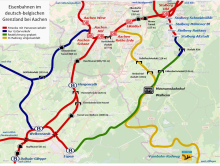Nirmer tunnel
| Nirmer tunnel | ||
|---|---|---|
| use | Railway tunnel | |
| traffic connection | High-speed line from Cologne to Aachen | |
| place | Eilendorf | |
| length | 125 m | |
| Number of tubes | 1 | |
| business | ||
| operator | DB network | |
| release | September 1, 1841 (old tunnel) April 4, 1966 (new tunnel) |
|
| location | ||
|
|
||
| Coordinates | ||
| East portal | 50 ° 47 ′ 17 " N , 6 ° 10 ′ 24" E | |
| West portal | 50 ° 47 ′ 16 " N , 6 ° 10 ′ 18" E | |
The Nirmer Tunnel is a 125-meter-long, double-track railway tunnel on the high-speed line Cologne – Aachen between Eilendorf and Stolberg .
history
Nirmer Tunnel (1841–1963)
With the construction of a railway line from Cologne to Aachen by the Rheinische Eisenbahn-Gesellschaft , a 727 meter long tunnel, which was designated as the Nirm tunnel , was built using the core construction method between Stolberg Hbf and the Nirm stop . The Nirmer Tunnel was started as the first tunnel on the Cologne-Aachen railway line. When building the tunnel, miners from the Eschweiler district were initially used. However, when problems arose during construction, the workers who had completed the Oberau tunnel in Saxony on the Leipzig – Dresden railway line were commissioned to build the Nirmer tunnel.
The Nirmer tunnel initially only crossed under an elevation west of the Propsteier forest , until 1963 the Autobahn 44 also used the tunnel to cross the railway line. There were eight brick chimneys on the tunnel to divert the smoke from the steam locomotives . During the Second World War, there was also a bunker above the west portal of the Nirmer Tunnel.
New building (1964–1966)
In 1963, the Federal Railroad pursued the electrification of its main lines to increase travel speed . The electrification of the route between Cologne and Aachen was prevented by the narrow cross-sections of the tunnels, which would not meet the clearance profile after the electrical overhead line was installed . While the Königsdorf tunnel was slit open and exposed as early as 1955, partial slitting was chosen for the Nirmer tunnel and for the Ichenberg tunnel near Eschweiler . The plans for the Nirm Tunnel envisaged slitting open the tunnel, which was built in 1841 and partially damaged in the Second World War , and building two independent new tunnel structures, both of which were to be 125 meters long. A cut was to be made between the two tunnels. Other variants had previously been discussed, including the expansion of the existing tunnel or the construction of a second, single-track tunnel tube.
The section of the Nirmer tunnel running under the motorway had to be expanded using mining techniques; this happened from December 1964 in sections about 3 meters in length.
The second tunnel was named Eilendorfer Tunnel ; its length was increased to 357 meters due to the discovery of flowing sand during the construction phase. The construction costs increased from the originally estimated 14.6 million DM to 30 million DM. While the first Nirmer tunnel was built with bricks , concrete was used for the new Nirmer tunnel .
The overburden that arose when the tunnel was cut open and the deeper cover was removed was used to backfill a neighboring limestone quarry .
business
After the new Nirmer Tunnel was opened to traffic in 1966, the Federal Railroad carried out high-speed tests in July 1967, including the E 03 series . The aim was to research the pressure behavior when trains meet in the tunnel at speeds of up to 200 km / h.
In 1982, movements of the soil in the area of the cut east of the tunnel were again detected. As a consequence, a track was temporarily swiveled and sheet pile walls were driven in. In 2012, the tracks in and around the Nirmer Tunnel were replaced. During construction, the tunnel was designed for the planned speeds of 200 km / h. The maximum speed allowed today is 130 km / h (as of 2014).
Web links
- Report with photos on the construction work on the Nirmer Tunnel up to 1966
- Information and pictures about the tunnel at www.eisenbahn-tunnelportale.de
Individual evidence
- ^ A b c d e Hans Schweers, Henning Wall: Railways around Aachen. 150 years of the international route Cologne - Aachen - Antwerp , Schweers + Wall, Aachen 1993, ISBN 3-921679-91-5 , pp. 160–162.
- ↑ a b high-speed route Cologne-Aachen on gessen.de , accessed on June 22, 2013.
- ^ Hans Schweers, Henning Wall: Railways around Aachen. 150 years of the international route Cologne - Aachen - Antwerp , Schweers + Wall, Aachen 1993, ISBN 3-921679-91-5 , p. 18.
- ↑ New Autobahn openings in 1963 at autobahn-online.de , accessed on June 22, 2013.
- ↑ Peter Packbier: Eilendorfer Views, p. 68 (pdf, 8.8 MB)
- ↑ Demolition of the Königsdorf tunnel on wisoveg.de , accessed on June 22, 2013.
- ↑ a b Demolition and construction of the Nirmer Tunnel on eisenbahn-stolberg.de , accessed on June 23, 2013.
- ↑ a b High-speed test drives between Stolberg Hbf and Aachen-Rothe Erde station in July 1967 on eisenbahn-stolberg.de , accessed on June 22, 2013.
- ↑ Photo of the construction work 2012 on bahnbilder.de , accessed on June 22, 2013.

